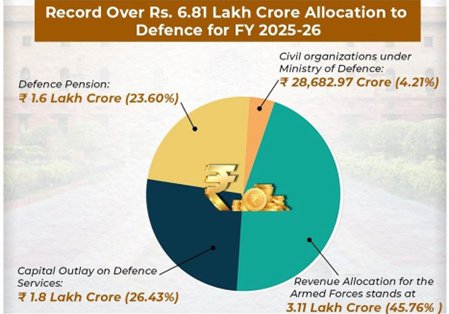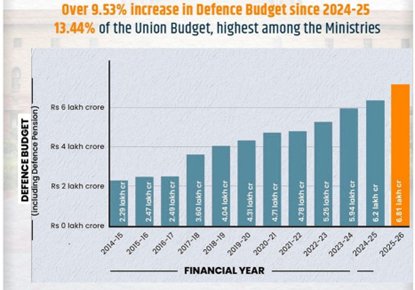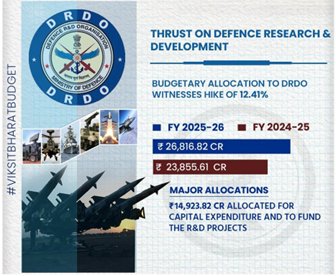DEFENCE ALLOCATION IN UNION BUDGET 2025-26

- On 1st February 2025, Finance Minister Nirmala Sitharaman presented the Union Budget 2025-26 with an allocation of Rs 6.81 trillion for the defence sector.
- This marks a slight increase from the Rs 6.22 trillion allocated in the previous fiscal year.
- However, the allocation remains 1.9% of India's GDP, continuing a gradual decline from 2.4% in FY21.

- This reduction in defence spending as a proportion of GDP has raised concerns, as some experts suggest that India should ideally allocate at least 3% of GDP for defence due to strategic threats posed by neighboring countries like China and Pakistan.
- The Ministry of Defence has also declared 2025 as its “Year of Reform”, aiming to overhaul the acquisition procedures for faster procurement and better readiness.
KEY ASPECTS
- Total Defence Budget Allocation:
- The total allocation for defence is Rs 6.81 trillion for FY26, a marginal increase from Rs 6.22 trillion in FY25.
- Defence expenditure as a percentage of GDP stands at 9% of India’s GDP, continuing a downward trend from 2.4% in FY21.
- Strategic Challenge: Experts argue India should be spending 3% of its GDP on defence to meet the growing security threats from China and Pakistan, both nuclear-armed neighbors.
- Defence Capital Outlay:
- The capital outlay has been set at Rs 1.8 trillion, showing a slight increase from Rs 1.72 trillion in FY25.
- Capital Expenditure is primarily for the procurement of weapons, aircraft, naval vessels, and defence infrastructure. Key breakdowns of capital expenditure:
- Rs 48,614 crore for purchasing aircraft and aero engines.
- Rs 24,391 crore allocated for the naval fleet.
- Rs 63,099 crore for purchasing other military equipment.
- Defence Revenue Expenditure:
- The revenue expenditure for FY26 is Rs 4.89 trillion, which includes Rs 1.61 trillion allocated for pensions for veterans and retired personnel.
- This allocation focuses on ongoing expenses such as salaries, maintenance, and pension payments for retired personnel.
FOCUS ON BORDER INFRASTRUCTURE & SECURITY
Border Roads Organisation (BRO):
-
- The allocation for the Border Roads Organisation has been increased from Rs 6,500 crore in FY25 to over Rs 7,000 crore in FY26.
- This increase signifies the government's emphasis on improving border infrastructure, especially in sensitive regions like Ladakh and the North Eastern States, ensuring better mobility and logistical support for the armed forces in border areas.
DRDO & INNOVATIONS
- Defence Research and Development Organisation (DRDO):
- The DRDO has been allocated Rs 26,816.82 crore for FY 26.
- This budget is aimed at strengthening India's indigenous defence technology, including cutting-edge advancements in missiles, radars, drones, and other advanced military equipment.

- Innovations for Defence Excellence (iDEX):
- An important initiative under this budget is the continued funding of the iDEX scheme, with Rs 450 crore allocated for promoting innovation and entrepreneurship in the defence manufacturing
- iDEX focuses on startups, MSMEs, academic institutions, and R&D institutes to foster collaboration for developing innovative defence technologies. This aligns with India's goal of achieving self-reliance in its defence sector.
- ADITI (Acing Development of Innovative Technologies with iDEX):
- The ADITI scheme, launched in 2024, is part of iDEX and offers grants of up to Rs 25 crore for R&D in critical defence technologies.
- Budget for ADITI: Rs 750 crore has been set aside for the period 2023-24 to 2025-26.
- Focus Areas: The scheme is addressing critical modern defence challenges in AI, quantum technologies, and military communications.
ABOUT iDEX & ADITI
1. iDEX:
- Launched in 2018, iDEX promotes innovation and technology development in India’s defence and aerospace sectors.
- It provides a collaborative platform for stakeholders such as startups, MSMEs, R&D institutes, and academia to develop innovative defence technologies.
2. ADITI:
- Launched in 2024, ADITI is a sub-scheme under iDEX that offers grants of up to Rs 25 crore for R&D in critical defence technologies.
- The scheme addresses defence challenges in areas such as artificial intelligence, quantum technologies, and military communications.
INCREASED FOCUS ON MARITIME SECURITY
- India’s strategic focus on maritime security is becoming increasingly important due to the country’s location in the Indian Ocean
- Although the specific breakdown of the Navy’s capital expenditure is not detailed in the official documents, experts predict that the Navy's share in the budget will rise in the coming years.
- This is part of India’s broader emphasis on naval power to safeguard its maritime interests, especially as maritime security becomes more crucial in global geopolitics.
ECONOMIC CONTEXT
- India’s Defence Position: India is the world’s 5th-largest economy and has the 2nd-largest standing army, but the growth in the defence budget has not kept pace with its economic growth.
- Security Threats: While India faces increasing security threats, particularly from its neighbours, the defence budget remains limited when compared to its economic stature.
- Balancing Priorities: India needs to balance its national security requirements with social development, as it remains the largest developing country by population.
While experts emphasize the need for
higher defence spending, there is also an acknowledgment of the need to
prioritize social development to maintain a balance between economic growth and security needs.
Note: Connect with Vajirao & Reddy Institute to keep yourself updated with latest UPSC Current Affairs in English.
Note: We upload Current Affairs Except Sunday.